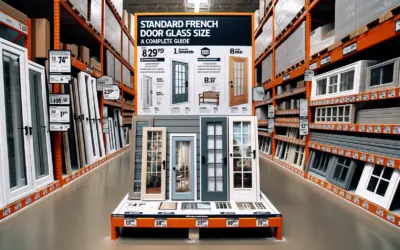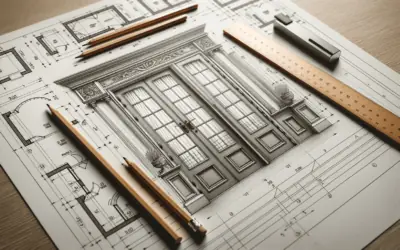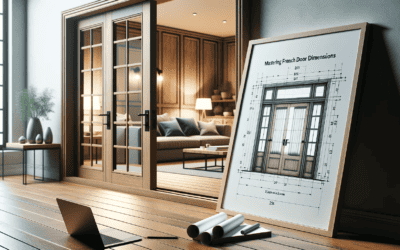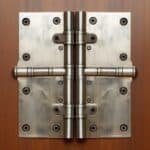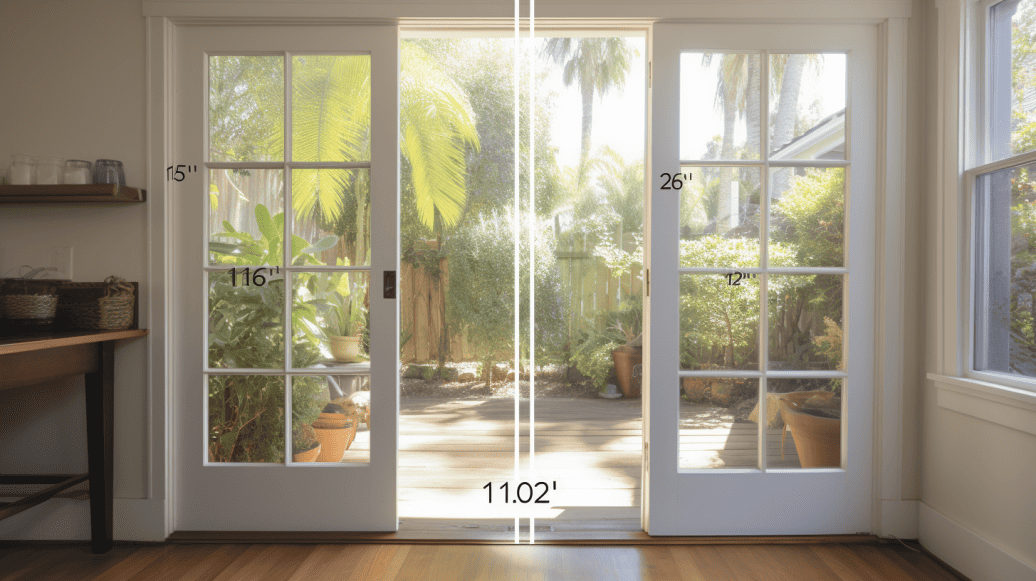
With their characteristic large glass panes and narrow stiles, these glazed double doors evoke European charm. But before picking out hardware and planning the big install, it’s important to understand what constitutes a standard size for French doors.
This comprehensive guide will break down the important dimensions of exterior and interior French doors. You’ll learn about:
- Typical heights and widths for standard interior and exterior sets
- Custom sizing options to fit any space
- Dimensions for sliding patio and specialty French door styles
- Cost considerations and variables by size
- Measuring your space correctly for new French doors
- Installation and delivery best practices
By the end, you’ll have the facts to choose the perfect French door style and size to suit your home. Time to let the fresh air in! Now, let’s dive into those all-important standard French door dimensions.
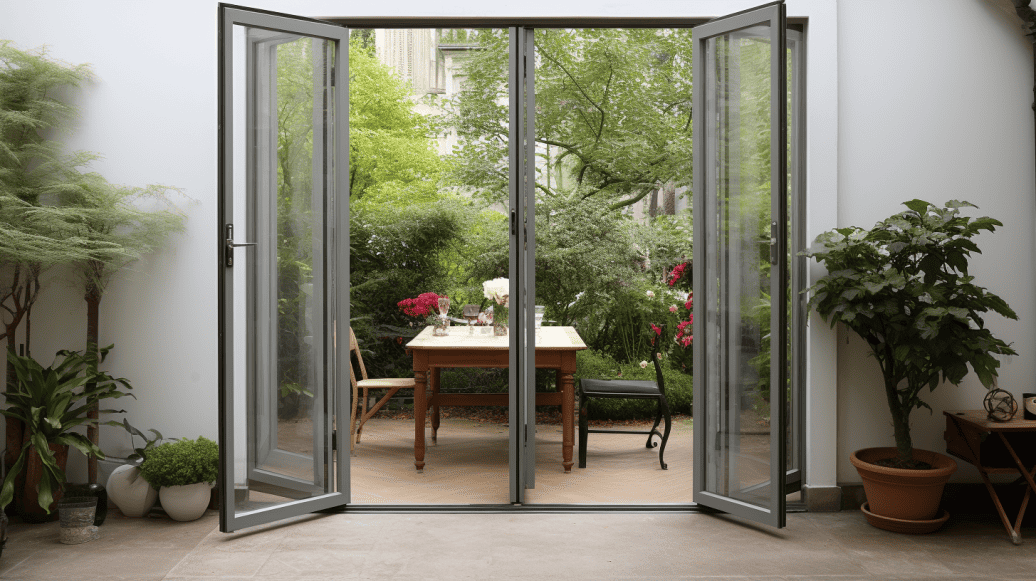
Typical Dimensions
When it comes to size, French doors come in standard dimensions for both interior and exterior settings. Understanding these widths and heights will ensure you get the right fit for your space.
Exterior French Door Sizes
Ideal for leading out to patios, decks, and porches, exterior French doors tend to be on the larger side. Here are the key measurements to know:
- Common heights:
- 80 inches (approx. 6 feet 8 inches)
- 84 inches (exactly 7 feet)
- 96 inches (exactly 8 feet)
- Typical widths: 60-72 inches (5-6 feet) per door
- Total widths: 120-144 inches (10-12 feet) for a double door
So, for a standard set of exterior French doors, you’ll usually see dimensions around the following:
- 80 x 72 inches (most popular)
- 84 x 72 inches
- 96 x 72 inches
The 80-inch height (around 6 foot 8) fits nicely under a standard 8-foot ceiling without appearing squat. Meanwhile, widths of around 5-6 feet per door allow for wide walkways and sweeping views.
For quantity, the classic exterior French door setup is the double door – two active doors side-by-side. This provides a grand entryway, letting you open just one door when desired.
Interior French Door Sizes
For joining rooms indoors, interior French doors favour narrower widths but can reach soaring heights. Common measurements are:
- Typical height: 80 inches (6 feet 8 inches)
- Typical widths:
- 36-48 inches (3-4 feet) per door
- 72-120+ inches (6-10+ feet) total double door width
So a standard interior set may be 80 x 60 inches (6 feet 8 inches x 5 feet). But for large, open-concept spaces, widths up to 12 feet or beyond are possible.
The narrower stile and rail construction makes interior French doors ideal for seamlessly connecting rooms without “closing off” the space. And the impressive heights add drama while allowing traditional 8-foot mouldings to continue uninterrupted above.
Now that you know standard exterior and interior sizes, let’s explore how to customize your French doors.
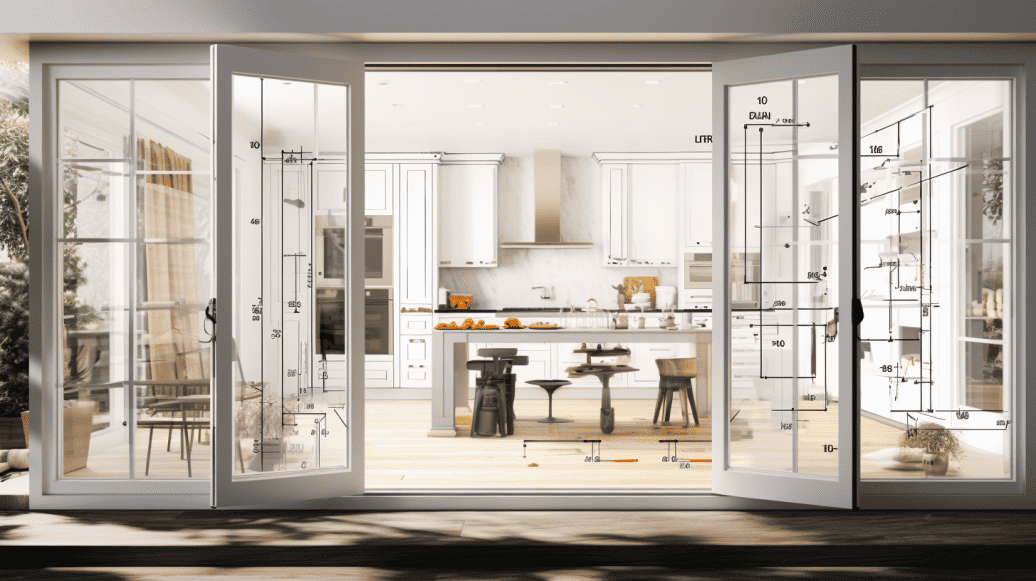
Custom Sizing Options
The beauty of French doors is their versatility – they can be customized to fit your space and style perfectly. Beyond the standard sizes, you have many options to fine-tune the dimensions to your needs.
Standard vs. Custom Sizes
French door manufacturers offer standard-size models as well as made-to-order custom options. Custom sizing allows you to specify non-standard dimensions for an exact fit.
Some key differences:
- Standard sizes are pre-made, often in stock and ready to ship immediately. This makes them quicker and more budget-friendly.
- Custom sizes take 2-6 weeks to manufacture but provide precision dimensions tailored to your opening.
- Custom doors incur added costs for the customization, so expect to pay 10-30% more than standard sizes.
Either standard or custom, accurate measurements are essential for a proper French door fit. We’ll cover measuring best practices later in this guide.
Height Options
When it comes to height, consider both aesthetics and function. Typical options include:
- 80 inches (~6 foot 8): The most common standard height. Allows room for traditional 8-foot mouldings above.
- 84 inches (7 feet): Gains you 4 extra inches of height for a grander feel.
- 96 inches (8 feet): A full 8-foot opening makes a dramatic statement but may require altering ceiling mouldings.
- Extra tall: For soaring spaces, doors up to 108 inches (9 feet) are possible. Adds emphasis, but harder to reach top hardware.
Scale drawings of different heights can help visualize proportions. Remember to account for transoms or other design elements, too.
Width Options
For width, it depends on your value of openness or privacy:
Narrow Widths (36-48 inches per door)
Pros:
- Increased privacy between rooms
- Easier to furnish small rooms
- Cost savings (less materials)
Cons:
- Limited views and light
- Can make rooms feel cramped
Wide Widths (60-72 inches per door)
Pros:
- Expansive views
- Invites light and airflow
- Grand, elegant proportions
Cons:
- Reduced privacy
- Harder to heat/cool open rooms
- Increased cost for larger doors
Expanding Width
For extra wide openings, options like sidelines and pocket doors allow flexibility:
- Sidelites – Narrow fixed panels flanking the doors. Expand the width without sacrificing the walkway.
- Pocket doors – Doors slide into the walls, opening 100% of the space. Great for small rooms.
Now that you’ve weighed height and width choices let’s look at sliding and specialty French door sizes.

Sliding & Specialty French Doors
Beyond traditional hinged doors, sliding and specially shaped French door styles suit your needs.
Sliding Patio Doors
For indoor/outdoor living spaces, sliding patio doors offer a smooth gliding action and wide openings without swing clearance requirements.
Typical dimensions:
- Widths: 9 ft (108 in) or 12 ft (144 in)
- Heights: floor to ceiling, often 80-96 inches
Pros:
- Expansive views and access to outdoor areas
- Space saving – no need for swing clearance
- Smooth sliding operation
- Can pocket the doors into the walls
Cons:
- Generally, only 2-panel doors, not French double doors
- Less ventilation than swing doors when partially opened
- Limited height adjustments since tracks are fixed
Sliding patio doors provide excellent light and seamless indoor-outdoor flow. Just be aware that sizes are more limited than hinged doors.
Specialty Shapes
Beyond rectangles, French doors can feature custom architectural shapes:
- Arched top doors in half-circle or elliptical designs
- Radius corners for a soft, contemporary look
- Geometric-shaped doors like angles and trapezoids
- Curved doors with unique shapes like circles or wavy patterns
Pros:
- Distinctive, upscale aesthetic
- Can match unique openings or architectural themes
- Made-to-order customization
Cons:
- Substantially higher cost due to customization
- Limited replacement and adjustment options
- Difficult for DIY installation
Specialty-shaped French doors make a bold design statement but require expert installation and higher budgets.
Now that we’ve covered special styles let’s move on to costs, measurements, and installation considerations.

Costs & Considerations
Beyond dimensions, costs and installation factors should guide your French door selection. Let’s break down what to expect.
Cost by Size
Budget is often a deciding factor for home projects. For French doors, several variables affect cost:
- Materials – Wood, fiberglass, or vinyl. Composite and steel cost less than wood.
- Quality – Entry-level, mid-range, premium options. Higher grades have sturdier construction.
- Customization – Standard vs. custom sizes. Made-to-order costs 10-30% more.
- Hardware – Upcharges for decorative handles premium finishes.
- Accessories – Sidelites, transoms and installation increase overall budget.
General cost ranges:
- Economy vinyl or fiberglass: $300-$800 per door
- Mid-range wood: $800-$1,500 per door
- Premium wood: $1,500-$3,000+ per door
- High-end custom: $3,000-$10,000+ for the set
Bigger is not always better for French doors. Oversize doors require extra materials and labor. Focus on the right proportions for your home rather than maximum dimensions.
Measuring for French Doors
Precise measurements ensure proper sizing and install. Key dimensions needed:
- Opening height and width – From top to bottom and side to side. For height, check multiple spots.
- Rough opening – The framing space for the doors. At least 1-inch wider and taller than the doors.
- Clearances – Space for swinging open without hitting walls or fixtures. At least 12-18 inches recommended.
Consult an installer for the full measurement process. On custom jobs, they may visit your site to measure.
Installation & Delivery
You’ll need to decide between DIY or professional install:
- DIY costs less but requires skills in framing, trimming, and hanging doors properly. Only advised for simple swaps of existing jambs.
- Professional install has added cost but ensures proper integration into weather barriers and home systems. Essential for new openings or custom work.
Most quality manufacturers offer free shipping. Lead time ranges from 2 days for in-stock models up to 6 weeks for custom orders.
Factor these considerations into your budget and timeline before purchasing French doors.

In this guide, you’ve learned the standard interior and exterior size conventions, from common widths and heights to total double-door spans.
We covered how custom sizing can help tailor French doors to your needs and architecture. You now know what to expect cost-wise based on materials, quality, and door dimensions. And we provided tips for accurate measurements and professional installation.
Armed with the facts on standard French door sizes and customization options, you can confidently assess if these elegant doors are the right choice for enhancing your home’s ambiance.
Just be sure to measure twice and hire professional installers for any new openings or custom work.
Frequently Asked Questions
What are the standard dimensions for exterior French doors?
What are typical interior French door sizes?
How wide can a set of French doors be?
Are there standard sizes for sliding patio French doors?
Can you get French doors in custom sizes?
What are the main factors that impact the cost of French doors?
Related Articles:
11 French Door Projects That Save Money and Are Surprisingly Easy to Tackle
French doors possess an almost magical ability to transform cramped, disconnected rooms into flowing, light-filled sanctuaries that feel twice their actual size. While most homeowners assume these elegant portals require professional installation and hefty budgets,...
12 Patio French Door Upgrades to Boost Curb Appeal Fast
Your patio French doors aren't just passageways; they're the handshake between your home's interior charm and outdoor beauty. After three decades of installing doors for thousands of homeowners, I've seen how even minor upgrades to these glass gateways can...
10 Ways to Use French Doors as Room Dividers Without Losing Light
Open floor plans give you that airy, spacious feel we all love, but sometimes, you need a slight separation without building walls that block your precious natural light. Over my career, I've installed hundreds of French doors, and I'm constantly amazed by how these...
17 Interior French Door Ideas That Instantly Open Up Small Rooms
Small rooms can feel like jail cells. I've walked into countless homes where owners apologise for their cramped spaces, not realising that the solid doors are the real culprits stealing precious light and flow. French doors can break down visual barriers without...
15 French Door Trends That Will Dominate Renovations This Year
The right French doors don't just connect rooms, they transform your entire home's feel. I've watched countless homeowners gasp when they see their spaces flooded with natural light after installing the perfect set. That dark hallway? Gone. The closed-off dining room?...
21 Stunning French Door Styles Designers Love
The moment you replace standard doors with French doors, something magical happens. Walls dissolve, light pours in, and rooms that once felt boxed-in suddenly breathe with newfound spaciousness. I've watched countless clients gasp when they see this single design...
15 Elegant French Door Inspirations to Elevate Your Bedroom Style
Your bedroom is the last thing you see before closing your eyes at night and the first thing that greets you each morning. Why settle for plain walls when you could wake up to the elegant silhouette of French doors framing natural light? These aren't just...
Charm and Elegance Unleashed: The Timeless Appeal of Timber French Doors
Timber French doors are a timeless architectural element that grace homes with elegance, natural warmth, and beauty. With their characteristic large glass panels surrounded by wide stiles and rails made of solid wood, these doors create an inviting transition between...
French Doors Buying Guide: An In-Depth Look
French doors are a popular choice for homeowners looking to enhance natural light, ventilation, and aesthetic appeal. With their characteristic large glass panes and narrow dividing frames, these elegant doors create an inviting indoor-outdoor flow. This comprehensive...
Standard French Door Glass Size: A Complete Guide
French doors are an elegant and timeless architectural feature known for their decorative glass panes that allow ample natural light into a space. But what are the standard glass sizes for these iconic doors? Understanding the typical dimensions of French door glass...
How Big Can French Doors Be in CM? A Complete Guide
French doors are a classic and elegant addition to any home. With their large glass panes and delicate dividers, they allow ample natural light into a space while providing a beautiful architectural focal point. But before installing these iconic doors, it's important...
Mastering French Door Dimensions: Your Ultimate Guide to Exterior Sizes
French doors are a classic and timeless architectural feature that can add elegance, charm and functionality to a home. As their name suggests, they originated in France but have been popular in the US and elsewhere for over a century. I'm a homeowner looking to...










